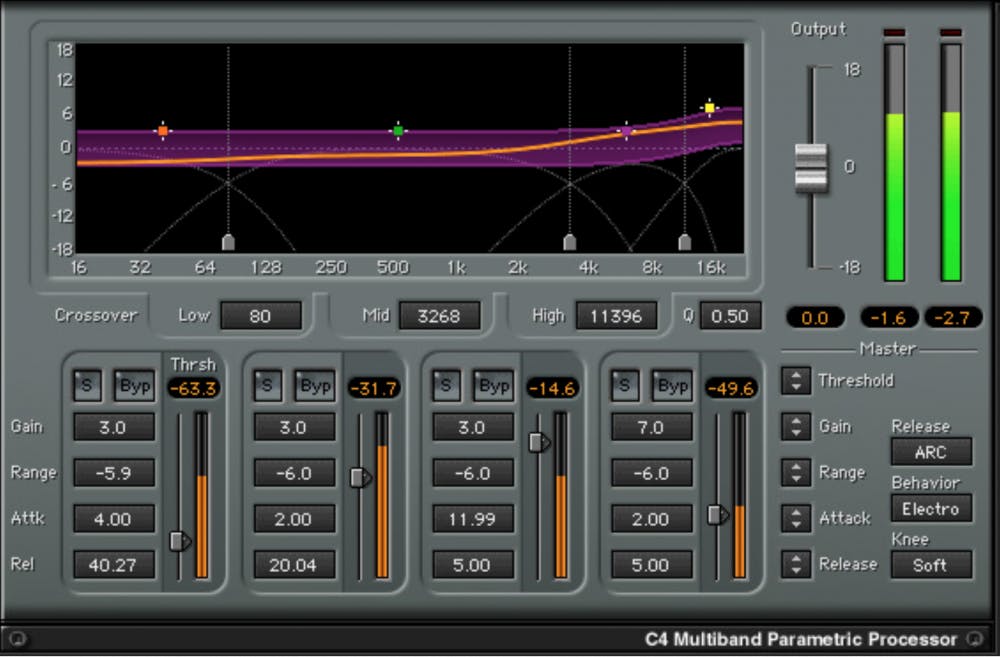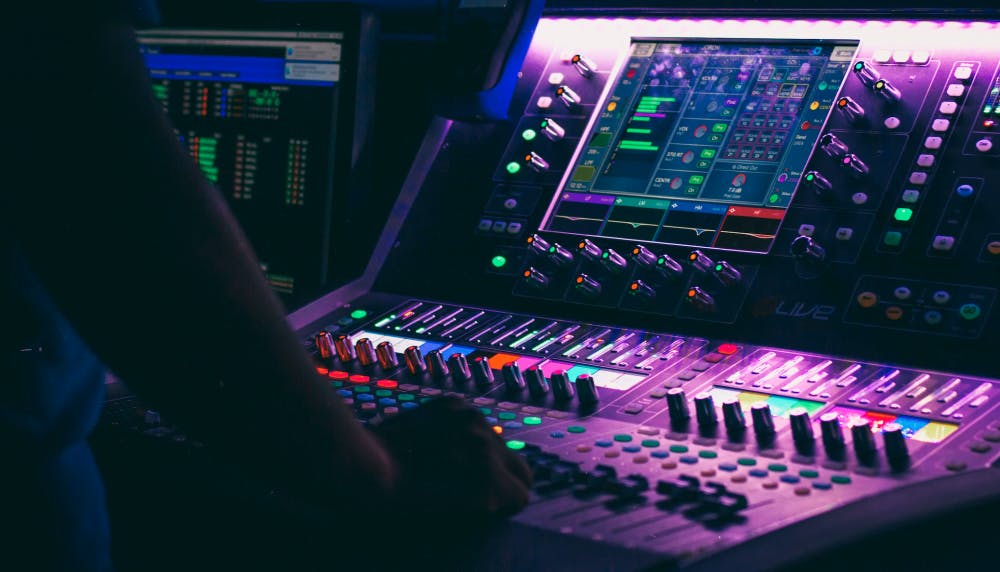In this article, you’ll learn about dynamic equalizers and multiband compression and when to use one, and not the other.
Multiband compressors and dynamic EQs, if used properly, are incredibly useful tools. They control dynamics over set frequency ranges, acting both as compressors and as EQs. Unsurprisingly, these two tools are often confused with each other, as they’re used in similar scenarios and often with similar results. However, it’s important to know which one to use, and when.
I’ll repeat my favorite mastering maxim that I heard from mastering engineer and educator Ian Shepherd: Do no harm. These tools are meant to fix problems, not create new ones.
How does a dynamic EQ work?
A dynamic EQ affects the sound by dynamically changing the gain of an EQ band. That is, the EQ analyzes the incoming signal and automatically raises or lowers different EQ bands to maintain a consistent frequency balance.
Dynamic EQs use the same terminology as equalizers, such as frequency, bandwidth (Q), and gain. Dynamic EQs also use the same terminology as compressors, like threshold, attack, and release. These three parameters even work in basically the same way they do in compressors.
When the signal level in a defined frequency range crosses the threshold (either above or below), the EQ band in question is boosted or dipped. The attack setting determines how quickly gain is applied to the EQ band and the release setting controls how quickly the EQ band goes back to its initial position.
Imagine a performer who keeps changing their distance from a microphone while speaking. When they move close to the microphone, the proximity effect will boost the low-frequency content in their voice. When they back away from the mic, a dynamic EQ can be set to similarly boost the low frequencies to maintain a consistent tone. In this case, the EQ is set so that when the low-frequency content falls below the threshold, gain is applied by the EQ—dynamically.

How does a multiband compressor work?
A signal’s frequency content is split into separate frequency bands, usually between three and six bands, by a series of crossover filters. Each band in a multiband compressor has its own compressor, with its dedicated controls for threshold, ratio, attack, release, and makeup gain (remember to use this one!). This processor behaves first as a compressor and then provides make-up gain for each band.

What’s the difference between a multiband compressor and a dynamic EQ?
A multiband compressor divides the audio into multiple, wide frequency bands. This happens before any compression is applied. Any changes made to a frequency band occur evenly across that single band. Additionally, simply dividing the audio into separate frequency bands and re-joining those bands will subtly change the sound by introducing distortion or phase shift artifacts.
Dynamic EQs don’t divide the audio into separate bands by default, so they don’t color the sound simply by passing audio. The shape of each EQ band can be controlled just like any parametric EQ, so precise changes can be made to specific frequency ranges. This makes dynamic EQs more surgical with possibly fewer artifacts than multiband compression.
When to use a dynamic EQ or a multiband compressor?
Both the dynamic EQ and multiband compressor are used when a static EQ or wide-band compression isn’t versatile enough. Sometimes an EQ change that works in one section of a song doesn’t work in another section. Sometimes a compressor reacts too much or too little depending on which frequencies dominate a mix at any given moment.
Let’s say the vocal you’re working on generally requires a high-frequency boost, when the singer belts, their voice becomes harsh in the high frequencies. You could automate the gain of an EQ band during those harsh bits, or you could use a dynamic EQ, with the threshold set so that the harsh frequencies are reduced when the singer belts.
For a drum loop or drum subgroup, a multiband compressor provides different attack and release times for different frequency ranges, so that you can optimize the low-band for the kick, the mids for the snare, and the highs for the cymbals.
Should I use a dynamic EQ or a multiband compressor?
When analyzing a sound or a mix, think about how much of the frequency spectrum you want to affect, that is, how broad or narrow an area you wish to affect. Then think about whether the problem feels like a frequency-based problem or a dynamic issue. For instance, in a mastering situation, a boomy kick drum is a frequency problem (EQ), but an uneven vocal mix is more of a dynamic problem (compression) over the midrange frequency range.
If you want to affect a precise range of frequencies, such as a vocal resonance or the ring of a snare drum, you’re better off using a dynamic EQ. On the other hand, the high-frequency band of a multiband compressor would work well as a wide-band de-esser. To me, compression also feels different than EQ, and sometimes I simply prefer the effect of one device over another.
Case studies
Here are a few specific scenarios where multiband compression or dynamic EQ works well.
Control a loud kick drum
A common challenge mastering engineers face is adjusting the balance between the low-end and the rest of the mix. Often the kick drum is simply too loud for the mix. In this case, a two-band multiband compressor is appropriate. You don’t want to split your sound into more bands than necessary.
Start with both bands set to similar ratio, attack, and release settings. You may adjust each band’s parameters separately, but starting with the same settings ensures the least amount of unintentional damage to your master! Set the low band to 250Hz or so (use your ears and solo the band to find where the kick ends and the snare bottom takes over) and set a quick attack and release, a moderate ratio, and lower the threshold for a couple of dB of compression when the kick hits. Adjust the timing and amount of compression to transparently push the kick back into the mix. The upper band compression can be set to do nothing or a bit of gluing, as needed.
Occasional low-end buildup
Another use for multiband compression or dynamic EQ is clearing up low-end buildup that occurs only occasionally. Remember, low-end is more than just kick and bass. In acoustic music, piano, acoustic guitars, and vocals all have low-end content that might need massaging and/or taming during mastering.
Traditionally, mastering engineers would go straight to a multiband compressor to fix low-end buildup. However, I strongly believe that a dynamic EQ can give you better, cleaner results than a multiband compressor for this application. Simply find the range where the buildup resides and set the threshold so that the processor only works when the buildup gets loud enough to muddy things up. The EQ band(s) can be shaped to only affect the frequency(s) that become overbearing. Sometimes a wide bell may be appropriate and sometimes a narrow notch may be called for.
Vocal Resonance
In certain cases when a singer belts out during a chorus, certain midrange frequencies become harsh or jump out. The mix engineer should have dealt with this issue in the mix, but many times the mastering engineer must also finesse this issue. Arm yourself with a dynamic EQ, locate the problematic frequency, and iron it out. Often only 1 or 2dB of dynamic attenuation with a narrow Q can significantly improve a master. Sometimes I find more than one vocal frequency that requires this attention, perhaps one in the nasal 1.8kHz range and one in the more strident 4kHz area.
A more advanced method for mastering may be to apply a mid-side dynamic EQ to process the lead vocal in the mid only. The opposite would work to tame overly bright cymbal crashes (sides) without dulling the vocal (mid). Many dynamic EQs operate in mid-side mode and some even provide an external sidechain input for further control options.
Uneven Bass Notes
Less experienced bass players might not have their technique down to a point where all the notes they play are at the same volume level. This problem is a performance issue that should be dealt with during tracking and mixing, but during mastering, this problem may also be further reduced.
For this case, first try a dynamic EQ; it might work. However, I find that multiband compression may be more effective here. Set the crossover points at the top and bottom of the frequency region you want to affect, then set the threshold so the note that’s poking out is brought down. Set the attack and release so that you get as transparent of a result as possible—probably a short attack (10 – 20ms) and medium release (30 – 100ms). A low ratio (1.5:1 – 2:1) will probably be more transparent while a higher ratio (3:1 – 4:1) will provide more firm control.
As you can imagine, these tips can be applied to a plethora of situations—boominess, muddiness, harshness, or sibilance. Think about how narrow or wide the frequency range is that you would like to process and decide if you have a dynamic problem in frequency range or simply an occasional frequency issue.
Conclusion
Multiband compressors and dynamic EQs each have their pros and cons. If you’re going for transparent results, using a dynamic EQ won’t disappoint. If you need to compress just a specific frequency range of your track, a multiband compressor will give you what you need, at the expense of adding some color to the sound. I tend to go first for a dynamic EQ unless I know I need what multiband compression has to offer.
Here are some additional articles on mastering that you may enjoy:
Pro Mastering Tips: Compression, by Adam Kagan
Pro Mastering Tips: Multiband Compression, by Adam Kagan
Pro Mastering Tips: Mid-Side Compression, by Adam Kagan
Recommended plugins for Multiband Compression and Dynamic EQ:



